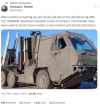How US Patriot defences are reducing ‘unstoppable’ Russian missiles to shrapnel
new
Kyiv and Zelensky HQ were on the brink of evacuation due to airstrikes in December
Maxim Tucker, Kyiv
Friday August 04 2023, 5.45pm BST, The Times
Share
With a hypersonic missile slung under its belly, a Russian MiG-31K bomber roared into the air from Savasleyka airbase, 180 miles east of Moscow. It was less than 24 hours after suspected Ukrainian drones had struck at the Kremlin, and the pilot had orders to exact revenge.
The jet dropped its load as it raced towards the Ukrainian border. A short fall, blaze of flame and trail of smoke later, the Kinzhal, or Dagger, was arching towards the atmosphere in the direction of Kyiv. Ukrainian air defence command had only minutes to stop the Mach 10 ballistic missile from striking the seat of President Zelensky’s government.
“We have an air situation tablet and when there is an inbound ballistic missile, a computer immediately registers it and draws a zone where it is supposed to hit,” a lieutenant colonel in the capital’s air defence command said in his first interview with international media. The Times has agreed not to publish his name to protect his relatives in occupied territory.
A Supacat truck armed to fire Asraams
“It calculates its target based on its trajectory. The system drew the centre of the circle exactly over the Maidan — they were targeting the government district precisely.”
President Putin described the weapon as “unstoppable”, yet it had never encountered American Patriot surface-to-air missiles, gifted to the Ukrainians just weeks before the May 4 attack. The Patriot battery’s automated systems engaged the $10 million weapon with their own missiles and within seconds the instrument of Putin’s wrath was reduced to shrapnel.
Ukraine now has more than two
Patriot batteries which have revolutionised its air defences and breathed new life into the embattled capital, defeating a series of attacks designed to wipe them out with no losses. Ukraine has even been able to dispatch a roving battery north to the border, where it surprised the Kremlin by shooting down five aircraft over Russian airspace in a single day, then south to support the counteroffensive.
“Around Kyiv we now have the most powerful air defence system in the world. And in fact throughout history,” the colonel said, claiming 215 Russian missile and drone intercepts over Kyiv in May and June alone. “It’s Patriots, it’s Nasams, it’s German Iris, S-300, it’s French Crotale. The Russians have realised that banging your head into the wall where it’s thickest is pointless.”
A skyscraper was damaged in a suspected Ukrainian drone attack in Moscow on July 30
AP
British ingenuity is also playing a role in the city’s defences, the colonel revealed. The Ministry of Defence has supplied a handful of Supacat trucks rigged by British engineers to fire advanced short-range air-to-air missiles (Asraam). They are deployed primarily to intercept swarms of Russia’s Iranian-supplied Shahed suicide drones, but some of the systems are also supporting Ukraine’s counteroffensive.
The high-mobility vehicles can enter an area where Russian attack helicopters are operating, shoot and move away. Unlike other systems like Starstreak, the Asraam do not require a line of sight and can lock onto targets themselves if fired into their vicinity.
Despite the array of advanced weaponry in Ukraine’s arsenal, the colonel warned that Kyiv would again be vulnerable this winter unless western partners drastically increased weapons production and urgently sent older, mothballed systems to Ukraine.
“You can’t plan a war with an annual production of 150-160 Patriot missiles. We fired those in a month,” he said, sounding the alarm that his men were running out of ammunition. “If we wait until autumn, until mid-October, they will hit the energy infrastructure again. This is a certainty. This winter will be even more difficult than the previous one.”
He disclosed that in December Ukrainian authorities had been on the brink of ordering the complete evacuation of Kyiv due to the intensity of Russian airstrikes. “Not many people know this, but Kyiv was on the verge of evacuation,” he said. “There was one battle that, in my opinion, determined the fate of Kyiv and the Russian campaign to destroy our energy sector, when 49 cruise missiles were launched at Kyiv.”
In a desperate 15 minutes on December 16, Ukraine fired dozens of missiles from its Soviet-era S-300, American Nasams and German Iris-T systems to save the city from total blackout in freezing temperatures.
“If we had allowed this strike to succeed, Kyiv would have had to be evacuated. And it is very difficult to evacuate two and a half million people,” the colonel said.
Without more missiles, his forces would be unable to protect those millions of people from sub-zero temperatures this winter, he argued, unleashing a new wave of Ukrainian refugees westwards toward the UK and the EU.
Ukraine fears Russia will once again strike energy infrastructure in Kyiv
GETTY IMAGES
The colonel accused some countries in the West of failing to grasp the nature of Putin’s threat to Europe and the response required. He said he had been told by western officials his air defence requirements were “too expensive”.
“The Baltic states are the people who really understand. They give everything they can give, because they realise that if we don’t endure, then they will definitely not endure. You fight, we give, that’s it. The Poles are very good. The Scandinavian countries helped a lot, which is not publicised. The Finns, the Swedes, the Norwegians, the Danes, the British, but the rest of the world is very hard. I had an experience with the French, when they didn’t understand, they said ‘Why don’t you surrender?’ They asked that directly, ‘why don’t you give up?’ ”
The shortage of missile supplies is also threatening to derail Ukraine’s counteroffensive, he added, saying the army had run out of munitions needed to dislodge the Russians at the end of May, forcing troops to “storm fortified points head-on”.
The colonel accused politicians of counting coins over lives and considering only the value of weapons provided rather than weighing it against the cost of storing, maintaining or destroying weapons approaching obsoletion.
“We received Nasams rockets produced in 1994. In 2024, they will reach their service life limit. The disposal of an Amraam AIM-120B missile is $26,000 to $28,000. It’s easier to launch it, give it to us. Give us these missiles, we will use them,” he said.
“I talk to the military, the Americans, the British. They understand us, they themselves can’t understand why they gave us 400 M113 APCs when they have 6,000 idling. It doesn’t cost anything. It’s already just standing there. It’s going to be scrapped. It has to be maintained or decommissioned.”
The Americans have 1,100 Patriot launchers, with 40 older PAC-2 batteries in permanent storage that could completely protect
Ukraine from Russian missiles, he said.
“They’ve already been paid for by the grandmothers of current US citizens. You either have them sitting around rotting away or you give them to us, we’ll use them somehow,” he added.
The Russians have adapted their tactics to avoid Patriot batteries, he said, focusing on striking cities far from the capital,
such as Odesa, which are not yet covered. They are also upgrading old missiles with advanced technology and radar-absorbent skins. In recent weeks Moscow’s focus has been trying to take out the Ukrainian airfields from where British Storm Shadow missiles are launched, hitting command and logistical centres deep inside occupied territory.
“The strikes on airfields are a tribute to Storm Shadow. Thank you very much, UK, because they really proved to be very effective. With Storm Shadow, you launch a trap missile and an anti-radar missile. All at the same time in the same direction. So the Russians, if they try to intercept Storm Shadow, get an anti-radiation missile hit on their radar. Plus traps. Very, very effective stuff.”
The colonel said that Storm Shadows actually had double their published range, some 500km rather than 250km, demonstrating there was no reason for the US to continue holding out on providing Atacms missiles with a similar range, but which can be fired by Himars ground systems already in service with the Ukrainian military.
“There’s a question for American politicians — Atacms. Why don’t you give them to us? Tell me, why not, why not? We already have a thing here that can get further than Atacms,” he said. “Yes, there’s a huge price to fighting Russia, a country with a military budget greater than our state budget. We’re willing to pay for it — with our lives. If anyone thinks money is more important than our lives, please say so. Don’t make promises and then give us the bare minimum. Say it now and we won’t count on you.”













 On 21 March 2022, the large landing ship Caesar Kunikov was hit by tactical operational missile complex "Tochka". The captain of the ship went to Kobzon;
On 21 March 2022, the large landing ship Caesar Kunikov was hit by tactical operational missile complex "Tochka". The captain of the ship went to Kobzon;
